The Major Scale on Guitar
The major scale is the most important scale in music theory, and today we will have a brief look at how to play it on guitar.
What Is The Major scale?
The major scale has seven notes, which we label 1 2 3 4 5 6 7.
The first note, note 1 is the root note. This is the note that we start from.
From 1-2 is a whole step.
From 2-3 is a whole step.
From 3-4 is a half step.
From 4-5 is a whole step.
From 5-6 is a whole step.
From 6-7 is a whole step.
From 7-8 is a half step.
8 is the same note as 1, but an octave higher.
Root notes are sometimes referred to as the key.
Here is an easier way to think about the above pattern:
1 (w) 2 (w) 3 (w) 4 (h) 5 (w) 6 (w) 7 (h) 8
Where (w) is a whole step and (h) is a half step.
Or, w w h w w w h.
A whole step is also known as a tone, and a half step is known as a semi-tone.
The pattern of whole and half steps is also known as the scale formula.
The different notes are sometimes referred to as degrees, e.g. the 3rd note is the 3rd degree, the 5th note is the 5th degree, etc.
Intervals in the Major Scale
If we look at each note in the major scale, we can look at the distance of that note from the root note. This distance is known as an “interval”. Each interval in the major scale has it’s own label:
- Note 2: Major second. Two frets from root.
- Note 3: Major third. 4 frets from root.
- Note 4: Perfect fourth. 5 frets from root.
- Note 5: Perfect fifth. 7 frets from root.
- Note 6: Major sixth. 9 frets from root.
- Note 7: Major seventh. 11 frets from root.
Intervals are sometimes referred to as note names. Note names and interval are interchangeable.

One String Major Scale on Guitar
When working out examples of this scale on guitar, a whole step is two frets, and a half step is one fret. If you are on fret 5 on the second string, and go up a whole step, you will be on fret 7. If you are on fret 1 on the first string and go up a half step, you will be on fret 2.


C Major Scale on Guitar
To work out a C major scale, we can start from any C on the guitar. Let’s start with the note C on fret three of the fifth string:

If we follow the pattern of whole and half steps that we outlined at the start, we will get the following notes:
C D E F G A B
and these are the notes in a C major scale:

Here is a tab of how we can play the C major scale on the fifth string:

A Scale on Guitar
If we want to work out the notes in an A scale, we go through the exact same process as above, except we start on the note A. Here we are treating A as the root note, or, the key of the scale.
If we start from A on the 6th string (low e), we will be start from fret 5:

We can then follow the scale formula along the string, to find the rest of the notes in an A major scale:

As you can see, we get the notes: A B C# D E F# G#.
Here is a one string tab for the A scale:

Differences Between Major Scales
There are two ways we can differentiate between major scales:
-
By their root note.
-
By the amount of accidentals they have.
In the examples we looked at with A major and C major, we can see that A major has three sharps, and C major has no sharps and no flats. This is why C major scale is often used for music theory examples, it is easy to work with.
If we look at a Bb major scale, we would get the notes: Bb C D Eb F G A. We can see that a Bb major scale has two flats.
How To Play Major Scales On Guitar
We’ve looked at how to play a C major scale along a single string. By applying the major scale formula from the note C, we worked out that a C major scale has the notes C D E F G A B.
There are two main approaches to playing a major scale on guitar:
CAGED Major Scale (C Major)
This way of playing the scale closely outlines a major arpeggio. It alternates between having two notes and three notes per string. Here is how we can play C major scale:

In the above diagram, the red notes are the root notes. The numbers inside each dot show the finger that should be used to play that note.
The advantage of this shape is it closely outlines the arpeggio shape. The disadvantage is that by alternating between two notes and three notes per string, you have to string skip to play through it, which makes it harder to play this scale fast.
Here is a tab for the CAGED C scale:
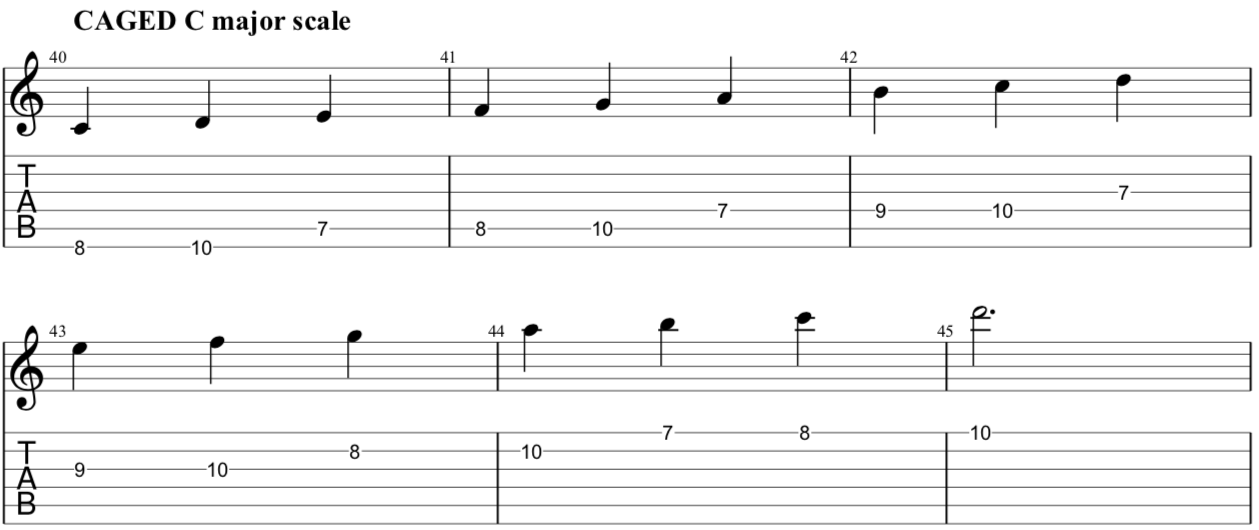
This is for the first CAGED position.
3 Note Per String Major Scale (C Major)
In this system, we use three notes for each string, as follows:

In the above neck diagram, each dot as a number on it. These numbers are the fingerings that you should use to play that note:
- First finger
- Second finger
- Third finger (middle finger)
- Fourth finger (little finger)
If you use each finger and indicated, you will find the scale easier to play, when playing it in different positions.
Note that when playing through this pattern, you will use the same fingers when ascending and descending.
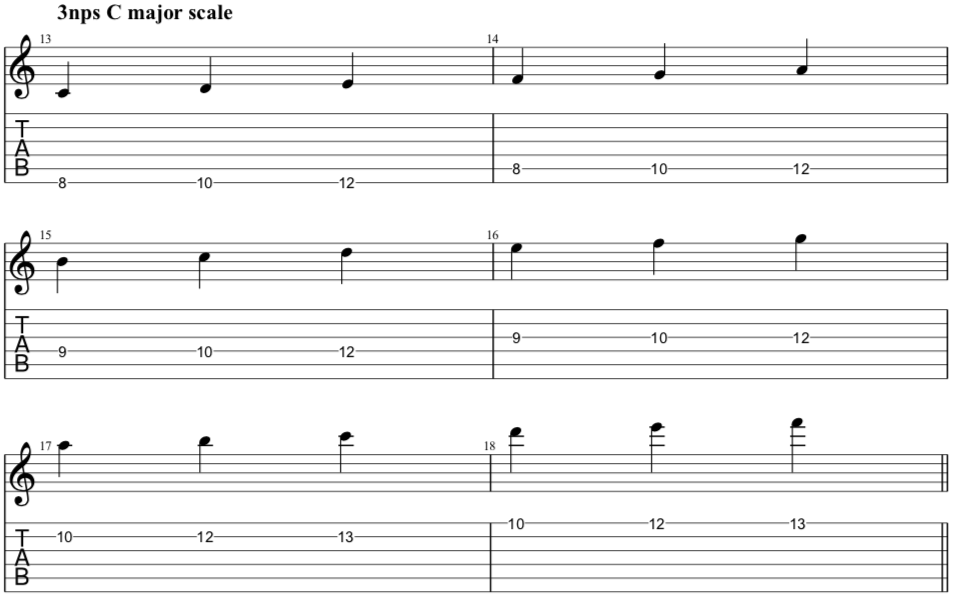
It’s important that, when practising, you use the same fingerings every time you play the scale.
The above pattern is a compact way to fit the scale notes on the fretboard, in a single hand position.
Playing the scale this way allows us to keep our hand in a single position - we do not have to move our hand all over the neck.
Another benefit to the 3nps system us that your pick is always in the correct direction to goto the next string. This makes it easier to play faster.
Major Scale Octaves
This pattern plays through two and a bit octaves.
Here you can see octaves of the scale:
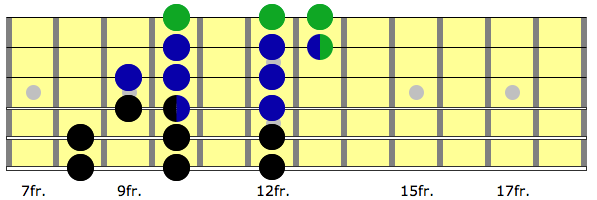
The first octave is in black, the second octave is in blue, and the partial third octave is in green.
What Chords Can You Play Over?
You might be wondering what chords you can use to improvise over.
You can play the scale over any major chord with the same root note.
For example, you can play C major over a C chord. You can play G major over a G chord.
If you have a go at this and find that some of the notes sound a bit dissonant, just move to a note before or after and you will find a note that fits better.
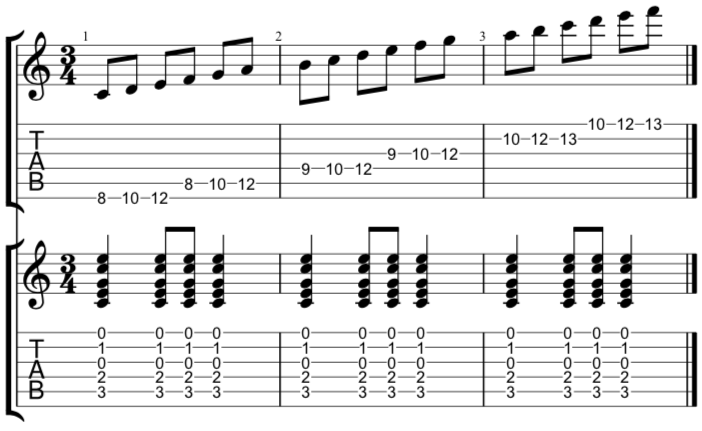
Relative Minor
Every major scale has a relative minor scale - a minor scale with the same notes.
The relative minor always starts from the 6th note of the major scale.
For example, the relative minor of C major is A minor. The relative minor of A major is F# minor.
Covering minor scales requires their own lesson. You can see some articles on [minor scales and their formula here]({{ < ref “/blog/2021-05-16-minor-scales-on-guitar“ >}}), and here is a [lesson on the chords in minor scales]({{ < ref “/blog/2021-06-13-minor-scales-chords“ >}}). The lesson on chords will help you write [creative chord progressions]({{ < ref “/blog/2021-06-20-minor-key-chord-progressions“ >}}). There is also a [lesson on neoclassical chords here]({{ < ref “/blog/2022-05-14-neoclassical-chord-progressions“ >}}).
Major Scale Lesson
Now that we have looked at the theory behind the major scale, let’s do a simple lesson to get you playing through the scale.
Take this three note per string major scale:

By changing the note of the scale that you start on, you can change its key. The fingerings are the same in every key.
Here are some examples in different keys:
C major
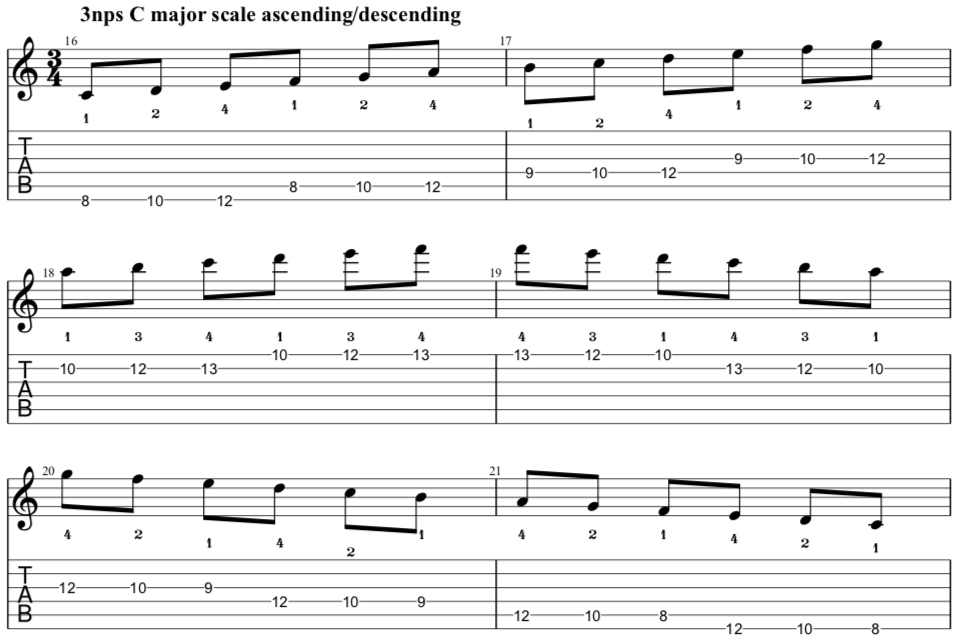
G major
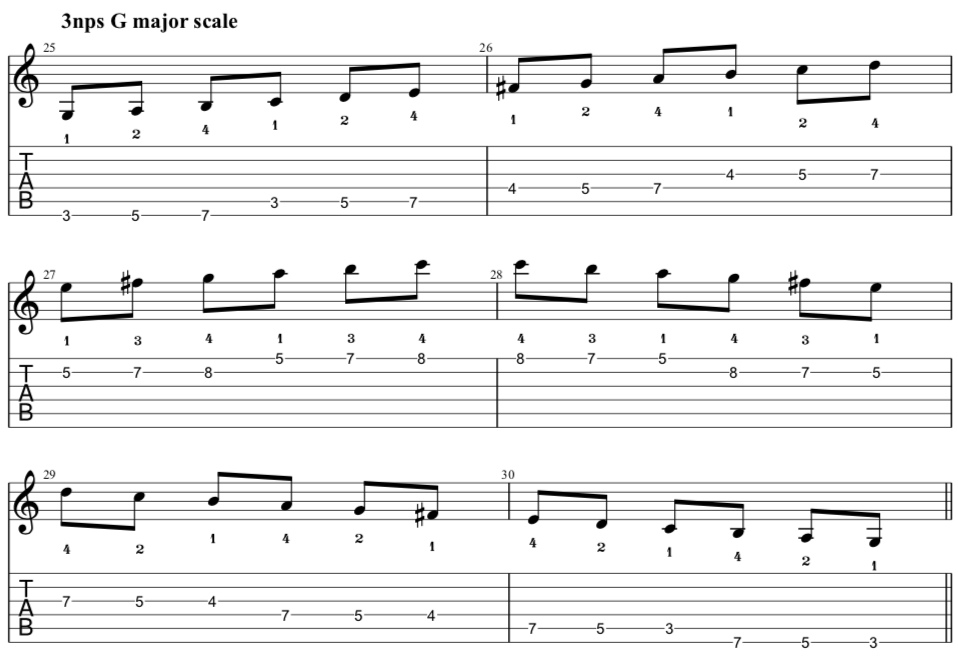
D major
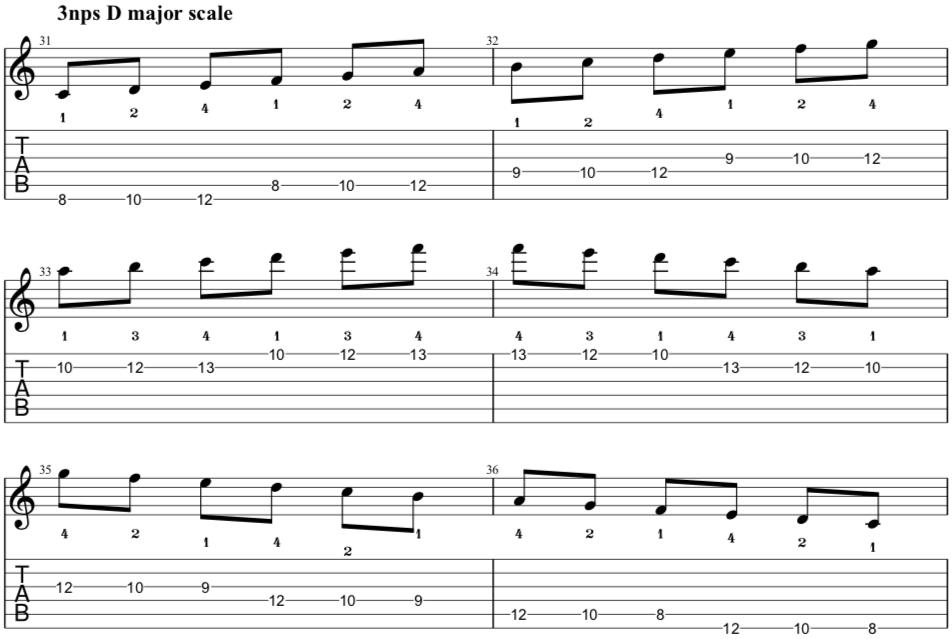
A major
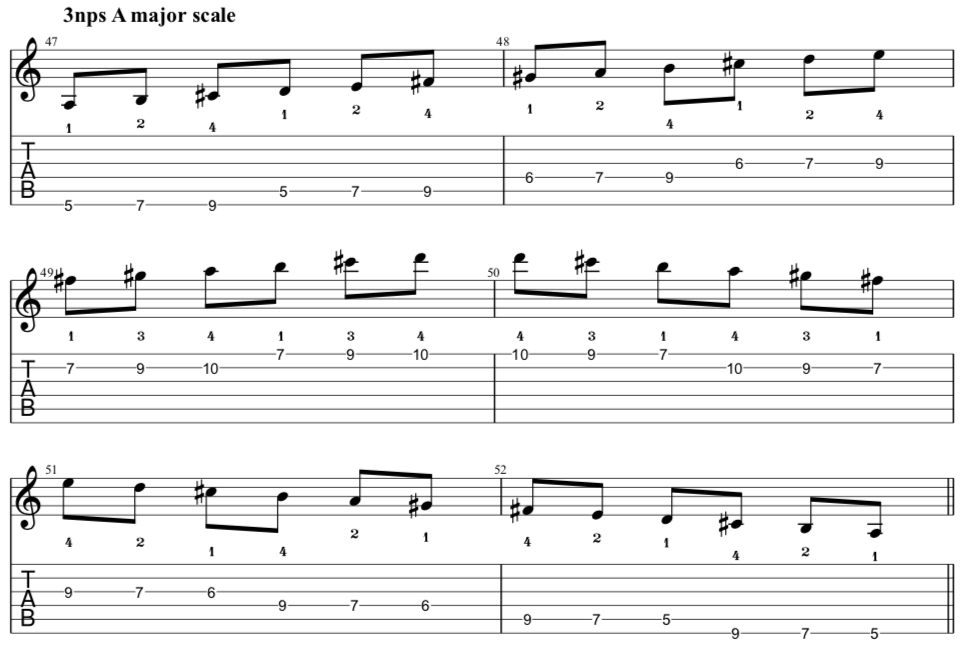
E major
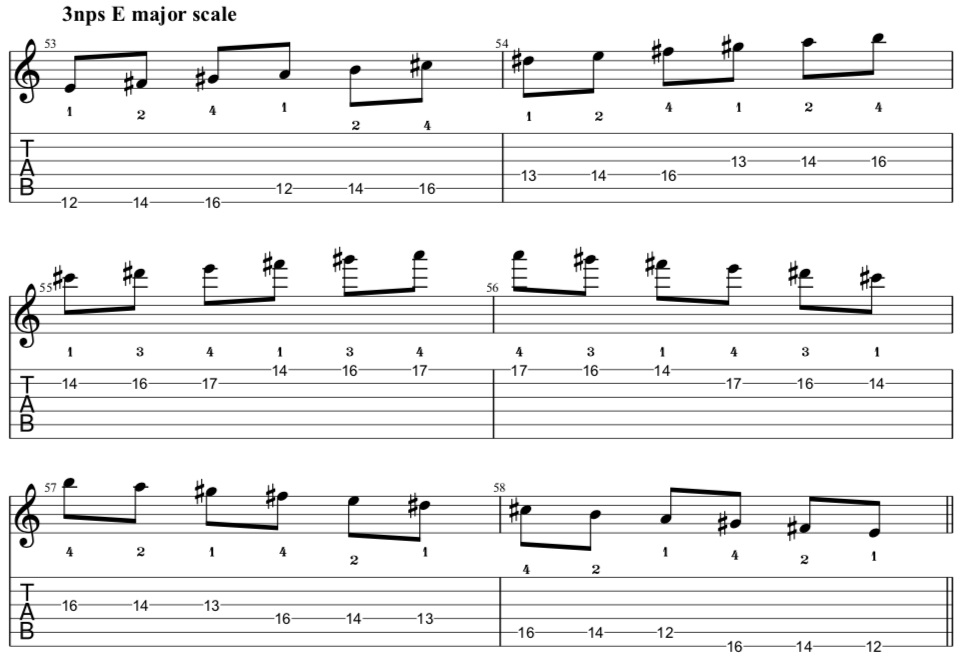
B major
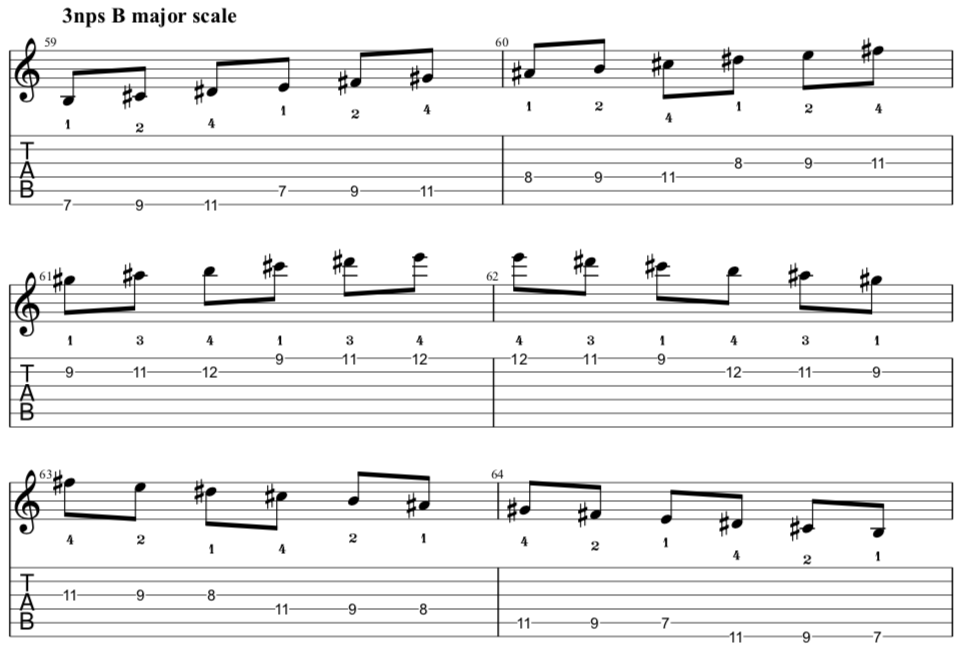
You can practice playing the scale in the above positions, and also in the following positions:
C G D A E B F# Db Ab Eb Bb F
You could make an audio recording of yourself playing the above pattern as major chords, and then play over the top. Where possible, play in both octaves, e.g. you can play A scale from the 5th and the 17th fret on the low e string. Try playing a C major scale over a C chord.
You should also work on memorising the formula of the scale and the intervals in the scale.
How to Practice This Lesson
Here are some ways you can practice this lesson:
- Draw out the scale pattern on blank neck diagrams. This will help you memorise it. Check your diagrams with the diagrams in the article.
- Play through the 3nps major scale pattern on guitar, using a metronome. Play the scales ascending and descending. Make sure you use the same fingerings every time - the given fingerings are the best possible fingerings to use. Start with a C major scale and work through the circle of fifths.
- Make your own audio recordings of different major chords and play the major scale over them. You could use a looper pedal.
- Record audio of yourself playing with a metronome to check your timing.
- Find a friend. Have them play a chord and call out the appropriate key you should be playing and improvise over that chord.
- Play the different intervals in the scale and memorise them. This is a good way to learn the intervals.